The world’s southernmost town becomes expedition cruise hub
There’s a melancholy to Antarctica’s beauty. The South Shetland Islands are lush with thawed vegetation. Ice-melt spools towards the bay in glassy rivulets; sedimentary ledges are streaked absinthe with lichen. The continent seems unclothed in the clouded light, vulnerable against the great tide of summer heat and warming oceans.
“Every time you go back, there are subtle changes,” says Silversea’s lead kayak guide, Megan Savage. “Sometimes I’ve been wearing a t-shirt onshore.”
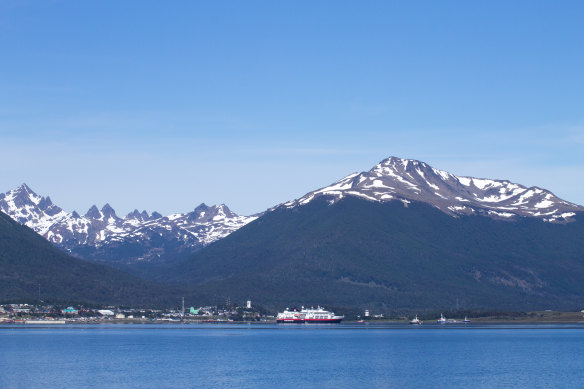
Puerto Williams, the world’s southernmost city.Credit: iStock
It’s not lost on me, the irony of revisiting this fragile continent amid the slew of cruise ships carving a path through friable sea-ice to get here. But these subtle changes originate in places far-distant from this remote continent. The polar regions are, after all, barometers for climate change; those of us fortunate enough to visit must bear witness to their inexorable transformation.
“People say, ‘Oh, but you work in these places, are you not contributing [to climate change]?‘” Savage says. “Yes, I’m contributing, but I think education, how to spread the word and how to get it across to people [is important]. We need to get people to come down here and see that it’s worth keeping and worth preserving.”
It’s a balance finely-struck by Silversea. Its new expedition ship, Silver Endeavour, is the first to be christened inside the typically ice-plugged Lemaire Channel. The ship’s departure from the world’s southernmost town, Puerto Williams, hints at this quest to address both the burgeoning demand for polar travel and the environmental preservation so essential to its longevity. Until now, the settlement on Navarino Island in the Chilean Antarctic Province has been bypassed by cruise ships on their way south from Ushuaia or Punta Arenas. Silversea hopes its new departure hub – developed here in collaboration with DAP Antarctic Airways, local government and community groups – will help relieve pressure on the region’s other ports and develop the town’s economy.
“It started off from a desire to differentiate ourselves from the rest of the industry,” acknowledges Silversea’s Conrad Combrink.
“But it’s become more about Puerto Williams … The phase we are in right now, is establishing [local] industry to support the cruise industry, and that really is where the economic benefit is for the community. I think we have a responsibility, as a cruise industry, to leave a positive impact in these destinations.”
The DAP Antarctic Airways plane – liveried in imitation of a chinstrap penguin – departs from Santiago and dips across a crenulated, ice-threaded frontier before landing on the world’s southernmost commercial airstrip at Puerto Williams’ Guardiamarina Zanartu Airport. Home to the Yahgan people, this island operates as a naval base, hub for Antarctic research and, most recently, a launch pad for Silversea’s expedition fleet.
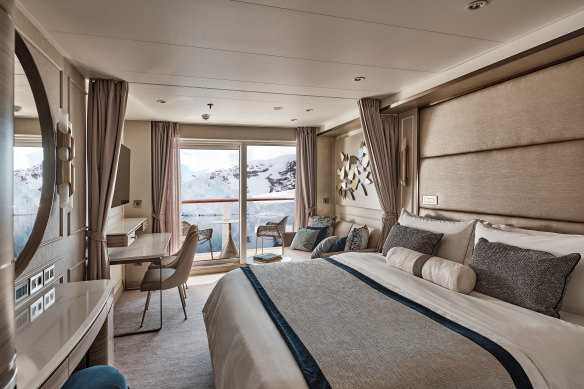
This ship features sumptuous suites with butler service.
To the north lies the Beagle Channel, to the south the fearsome Drake Passage (fly-cruise itineraries bypass the passage, departing instead from King George Island). Tormented by memories of previous crossings, I brace for two days of hell. But they don’t materialise. The ship skates across the passage, noiselessly deflecting four-metre swells. Albatrosses glide like ghosts on the updrafts; giant petrels rise and sway in defiance of the ship’s unwavering rhythm. A day-and-a-half in, we spy land: the South Shetland Islands.
“It was smooth sailing since Marseille [from which the ship originally departed], so we needed a bit of rock ’n roll,” says Captain Niklas Peterstam as we prepare to anchor off Robert Island.
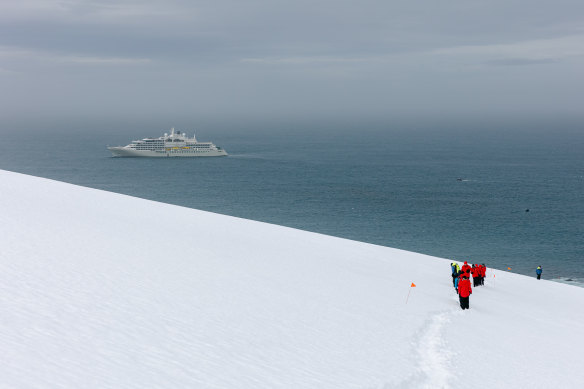
Robert Island shore excursion.
The voyage was more lullaby than jitterbug, a consequence of innovations such as state-of-the-art stabilisers and a dynamic positioning system. In more than 40 years on the high seas, Peterstam says, the Silver Endeavour “is the most interesting ship I’ve ever been in charge of”.
Passengers are equally enthralled. Said to be the world’s most luxurious expedition ship, the Silver Endeavour balances indulgence with practicality: sumptuous suites with butler service; superb cuisine at multiple restaurants and bars; a swimming pool, hot tub and spa; lounges in which lectures are delivered by authoritative figures; spacious mudrooms in which to prepare for excursions. In short, this is an opulent cocoon with a dress-circle view of the otherworld unspooling beyond. But might those who are accustomed to travelling in such style be inoculated against the consequences of environmental decline in places few people have the privilege of seeing?
“One can only hope that once people leave Antarctica, they become ambassadors for Antarctica, and they spread the word through lobbying, make sure governments understand that there is a very strong desire from the population [for] Antarctica to be preserved,” Combrink says.
“So, becoming real advocates for the preservation of Antarctica, areas like [Australia’s] Kimberley, the Arctic. One really needs to hope that the people that travel with us – [many of whom] are influential, are wealthy guests – go home and not forget about it.”
And indeed, the White Continent lodges easily in one’s memory. Sailing silently, stealthily, into Neko Harbour next morning, I’m struck by deja vu: mountains billow against a cheesecloth sky; they’re flecked black where winter’s ice has peeled away. Iceberg keels glow neon blue from the depths. Penguins porpoise across the bay, punching bullet holes into its cellophane surface. This is a place that cannot be expunged from memory; its surrealist quality becomes enmeshed with one’s bones.
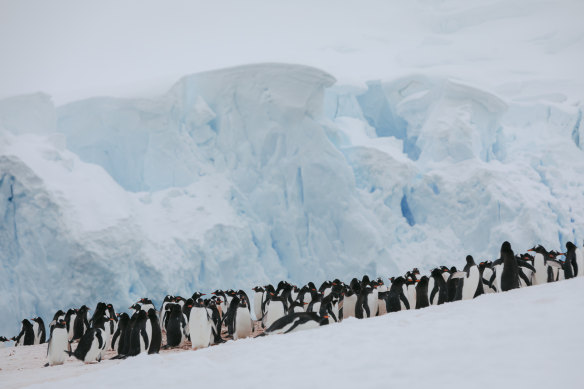
Penguin parade ... Neko Harbour shore excursion.
The polar cold is marrow-deep, too. Those clouds have tightened into black balls by the time I reach the ridge at our landing site. Snow begins to fall; wind burns my cheeks. Out in the bay, brash ice fastens itself to the ship like ghostly iron filings. On the opposite shore, cliffs of ice are poised for a fall. The monotone is broken only by a black-and-pink line scored across the ice: Gentoo penguins and, beneath them, a trail of krill-stained guano.
We are the solitary voyagers in this lonely domain. So strictly are landings regulated by the International Association of Antarctica Tourism Operators (IATO), cruise ships seldom encounter one another. Of the 300-odd approved landing sites, only 50 or so have guidelines for current use. Silversea hopes to expand this capacity – and so redistribute pressure on the environment.
“Our intention is to develop [open source] guidelines so we can spread out a bit more,” Combrink says. “We believe that the success of other companies in Antarctica is our success … [Cruise lines] have a very strong commitment of collaboration down here to make sure that Antarctic tourism always, always, remains responsible.”
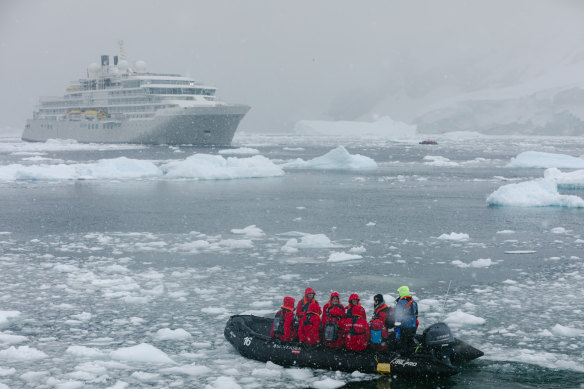
Zodiac excursion, Neko Harbour.
Brash ice crumbles like meringue in the ship’s wake as it navigates the Lemaire Channel next day. Leading the charge in Zodiacs, passengers raise their champagne flutes in readiness for a historic christening. High above us, godmother Felicity Aston – the first person to manually ski solo across Antarctica, in 2012 – shatters an ice-hewn magnum on the ship’s silver hull. Did the humpback whale we saw earlier hear the jangle of ice as it tumbled into its habitat?
Later, on Petermann Island, I encounter Aston in her own, adopted, habitat. The climate scientist, polar explorer and expedition leader lived in Antarctica for two winters while working as a meteorologist for the British Antarctic Survey; later, she spent 59 days traversing this hostile continent. Somehow, she still glows with a newcomer’s wonderment.
“When I first came back [to the UK] I used to get flashbacks quite a lot,” she says. “Sometimes I’d look out across the sea and instead of seeing waves, I’d see sastrugi [patterns on Antarctic ice sheets], and it would be a total flashback.”
Recently, Aston and a group of women traversed Iceland’s northernmost glacier on skis to collect snow and ice samples; they will be analysed for micro-plastics, heavy metals and black carbon. Though Iceland is a world away from Antarctica, the challenges it faces are universal. She recognises in Silversea a willingness to play their part.
“Yes, we want to see these wonderful places, but we want to see them in the right way, and with purpose,” she says. “We’ve got so much knowledge and technical ability, we’ve got the answers to so many problems, and there are lots of people out there pushing us towards that future.”
The writer was a guest of Silversea.
THE DETAILS
FLY
Qantas flies to Santiago from Sydney and Melbourne. See qantas.com.
CRUISE
Suites on Silversea’s 10-day Antarctic cruise to and from Puerto Williams starts from $25,600 a person. Suites on the six-day fly-cruise to and from King George Island from $25,900 a person. Prices include international economy class airfares, internal business class flights on DAP Airline, fully inclusive accommodation and activities. Longer itineraries are available. See silversea.com
Sign up for the Traveller Deals newsletter
Get exclusive travel deals delivered straight to your inbox. Sign up now.